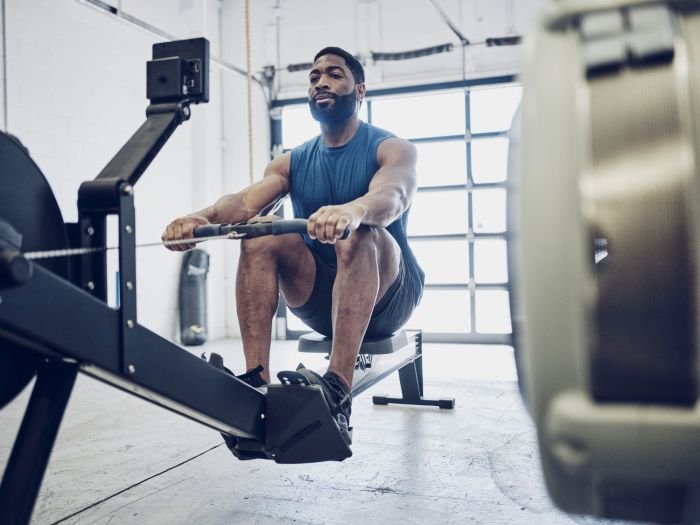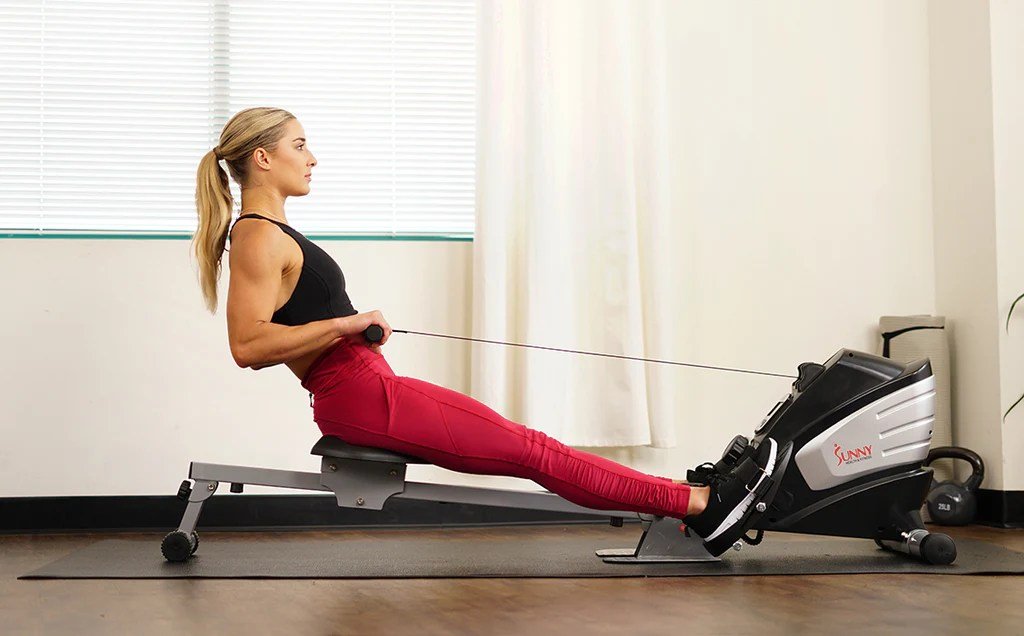Rowing for fitness offers a dynamic and engaging workout that strengthens your entire body, improves cardiovascular health, and enhances overall well-being. From its origins as a competitive sport, rowing has evolved into a popular fitness activity, accessible to individuals of all fitness levels.
The rhythmic motion of rowing engages major muscle groups, including the back, legs, core, and arms, providing a comprehensive workout. Whether you choose a traditional rowing machine or an outdoor rowing experience, the benefits of rowing extend beyond physical fitness, promoting mental clarity and stress reduction.
Introduction to Rowing for Fitness
Rowing is a fantastic full-body workout that provides numerous physical and mental benefits. It’s a low-impact exercise that engages multiple muscle groups, making it suitable for people of all fitness levels.
History of Rowing for Fitness
Rowing has been practiced for centuries, initially as a mode of transportation and later as a competitive sport. In the late 19th century, rowing became popular as a fitness activity, with the invention of rowing machines. These early machines were designed to mimic the motion of rowing on water, providing a similar workout experience.
Today, rowing has evolved into a widely recognized and effective fitness regimen, accessible to individuals seeking a comprehensive and engaging workout.
Types of Rowing Machines, Rowing for fitness
There are various types of rowing machines available, each with its own advantages and disadvantages.
- Water Rower: This type of rowing machine uses water resistance to create a smooth and realistic rowing experience. Water rowers offer a challenging workout and are known for their quiet operation.
- Air Rower: Air rowers utilize air resistance to provide a workout. They are typically more affordable than water rowers and are known for their versatility, as the resistance can be adjusted.
- Magnetic Rower: Magnetic rowers use magnets to create resistance. They are known for their smooth and quiet operation, making them suitable for home use.
Rowing Technique and Form
Mastering proper rowing technique is crucial for maximizing your workout, preventing injuries, and enjoying the benefits of rowing. It involves a coordinated sequence of movements that engages multiple muscle groups, allowing for efficient and powerful strokes.
Posture and Body Mechanics
Proper posture is the foundation of good rowing technique. Maintaining a straight back, engaged core, and relaxed shoulders is essential for efficient power transfer and injury prevention.
- Sitting upright:Sit tall on the seat, with your back straight and shoulders relaxed. Avoid slouching or hunching, as this can put strain on your back and neck.
- Engaging your core:Keep your abdominal muscles engaged throughout the stroke, helping to stabilize your body and prevent lower back pain.
- Relaxed shoulders:Avoid tension in your shoulders. Let your arms hang naturally, and keep your shoulders relaxed and away from your ears.
Tips for Maintaining Correct Form
Consistent practice and attention to detail are key to maintaining proper rowing form.
Rowing is a fantastic full-body workout that strengthens your core, arms, and legs. If you’re looking for a low-impact exercise option, consider checking out the comprehensive fitness programs offered by st elizabeth mercy health. They can help you find the perfect rowing routine to meet your fitness goals and stay injury-free.
- Focus on your catch:The catch is the initial phase of the stroke, where you engage your legs, core, and arms to pull the handle towards you. Ensure your back is straight, and your shoulders are relaxed. Avoid pulling with just your arms, as this can strain your shoulders and reduce efficiency.
- Maintain a smooth and controlled stroke:Avoid jerky or rushed movements. Keep your stroke fluid and controlled, focusing on a smooth transition between phases.
- Pay attention to your finish:The finish is the end of the stroke, where you extend your arms and lean back slightly. Ensure your back remains straight and your core engaged. Avoid overextending your arms or leaning back too far, as this can put strain on your back and shoulders.
- Use a mirror or video feedback:Watching yourself row can help you identify any form errors and make adjustments. You can use a mirror, a video camera, or a rowing app with video feedback capabilities.
Common Rowing Mistakes
Understanding common rowing mistakes can help you avoid them and improve your technique.
- Pulling with just your arms:This can lead to shoulder strain and reduced efficiency. Remember to engage your legs and core to generate power, not just your arms.
- Rounding your back:A rounded back can put strain on your lower back and reduce your power output. Maintain a straight back throughout the stroke.
- Overextending your arms:This can strain your shoulders and reduce your power output. Keep your arms slightly bent at the finish.
- Leaning back too far:This can put strain on your back and reduce your power output. Lean back slightly at the finish, but maintain a straight back.
Rowing Workouts and Training Plans

Rowing workouts can be designed to improve various aspects of fitness, including cardiovascular health, muscular strength, and endurance. Training plans can be tailored to different fitness levels and goals, from beginners to advanced rowers.
Rowing is a fantastic full-body workout that builds strength and endurance. For those looking for a comprehensive approach to health and fitness, tapestry health offers a holistic perspective. Their programs integrate various fitness disciplines, including rowing, to help individuals achieve their health goals.
Whether you’re a seasoned rower or a beginner, incorporating rowing into your fitness routine can provide a challenging and rewarding experience.
Beginner Rowing Workout Plan
This plan is designed for individuals new to rowing, focusing on building a foundation of strength and endurance.
- Warm-up:5 minutes of light rowing at a comfortable pace, followed by 5 minutes of dynamic stretching, such as arm circles, leg swings, and torso twists.
- Workout:
- 20 x 20-second intervals at a moderate pace with 20-second rest periods between each interval.
- 10 x 30-second intervals at a moderate pace with 30-second rest periods between each interval.
- 5 x 1-minute intervals at a moderate pace with 1-minute rest periods between each interval.
- Cool-down:5 minutes of light rowing at a comfortable pace, followed by 5 minutes of static stretching, holding each stretch for 30 seconds.
This workout should be performed 2-3 times per week, allowing for rest days in between.
Intermediate Rowing Workout Plan
This plan is designed for individuals who have some rowing experience and are looking to increase their intensity and duration.
- Warm-up:5 minutes of light rowing at a comfortable pace, followed by 5 minutes of dynamic stretching, such as arm circles, leg swings, and torso twists.
- Workout:
- 3 x 5-minute intervals at a moderate pace with 2-minute rest periods between each interval.
- 2 x 10-minute intervals at a moderate pace with 3-minute rest periods between each interval.
- 1 x 20-minute interval at a moderate pace with 5-minute rest periods between each interval.
- Cool-down:5 minutes of light rowing at a comfortable pace, followed by 5 minutes of static stretching, holding each stretch for 30 seconds.
This workout should be performed 3-4 times per week, allowing for rest days in between.
Progressive Rowing Training Plan for Advanced Users
This plan is designed for individuals who have a strong rowing foundation and are looking to improve their performance and endurance.
- Week 1:
- Monday: 3 x 10-minute intervals at a moderate pace with 2-minute rest periods between each interval.
- Wednesday: 2 x 20-minute intervals at a moderate pace with 3-minute rest periods between each interval.
- Friday: 1 x 30-minute interval at a moderate pace with 5-minute rest periods between each interval.
- Week 2:
- Monday: 3 x 10-minute intervals at a high pace with 2-minute rest periods between each interval.
- Wednesday: 2 x 20-minute intervals at a high pace with 3-minute rest periods between each interval.
- Friday: 1 x 30-minute interval at a high pace with 5-minute rest periods between each interval.
- Week 3:
- Monday: 3 x 10-minute intervals at a moderate pace with 2-minute rest periods between each interval.
- Wednesday: 2 x 20-minute intervals at a moderate pace with 3-minute rest periods between each interval.
- Friday: 1 x 30-minute interval at a moderate pace with 5-minute rest periods between each interval.
- Week 4:
- Monday: 3 x 10-minute intervals at a high pace with 2-minute rest periods between each interval.
- Wednesday: 2 x 20-minute intervals at a high pace with 3-minute rest periods between each interval.
- Friday: 1 x 30-minute interval at a high pace with 5-minute rest periods between each interval.
This plan can be repeated for several weeks, gradually increasing the intensity and duration of the workouts. It is important to listen to your body and take rest days when needed.
Benefits of Rowing for Fitness

Rowing is a full-body workout that offers numerous physical and mental benefits. It’s a low-impact activity that can be enjoyed by people of all ages and fitness levels, making it a versatile option for achieving various fitness goals.
Cardiovascular Benefits
Rowing is an excellent cardiovascular workout that elevates your heart rate and improves your overall cardiovascular health. The continuous motion of rowing engages multiple muscle groups, leading to increased blood flow and oxygen delivery throughout the body. Regular rowing sessions can help:
- Improve cardiovascular endurance:Rowing strengthens your heart and lungs, enabling them to work more efficiently. This translates to improved endurance and stamina for various activities.
- Lower blood pressure:The rhythmic nature of rowing helps regulate blood pressure by improving the elasticity of blood vessels.
- Reduce the risk of heart disease:Rowing strengthens the heart muscle, improves blood circulation, and helps maintain healthy cholesterol levels, reducing the risk of heart disease.
Muscle Strengthening
Rowing engages almost every major muscle group in your body, providing a comprehensive strength training workout. The pulling motion targets your back, arms, and shoulders, while the leg drive strengthens your quads, hamstrings, and glutes.
- Upper body:Rowing strengthens the muscles in your back, shoulders, arms, and core, improving posture and reducing the risk of injuries.
- Lower body:The leg drive in rowing engages your quads, hamstrings, glutes, and calves, improving lower body strength and power.
- Core:Rowing engages your core muscles throughout the movement, enhancing stability and balance.
Flexibility and Balance
Rowing requires a full range of motion, promoting flexibility and improving balance. The repetitive motion of rowing stretches and strengthens muscles, increasing joint mobility and flexibility.
- Improved flexibility:Rowing stretches and strengthens muscles, improving flexibility in the back, shoulders, arms, legs, and core.
- Enhanced balance:The coordination required to maintain proper rowing technique improves balance and coordination, reducing the risk of falls and injuries.
Rowing for Different Fitness Goals

Rowing is a versatile exercise that can be tailored to suit a variety of fitness goals. Whether you’re looking to shed pounds, build muscle, improve endurance, or enhance overall fitness, rowing can help you achieve your desired results.
Rowing for Weight Loss and Muscle Building
Rowing can be an effective tool for both weight loss and muscle building, depending on how you approach your training. For weight loss, focus on longer, lower-intensity rowing sessions, aiming for a steady-state cardio workout. This will help you burn calories and boost your metabolism.
You can also incorporate interval training, alternating between high-intensity bursts and periods of recovery. For muscle building, increase the resistance and shorten the duration of your rowing sessions. This will challenge your muscles and promote growth. Focus on proper form and technique to maximize muscle activation.Here’s a table that compares and contrasts rowing for weight loss and muscle building:
| Goal | Intensity | Duration | Focus |
|---|---|---|---|
| Weight Loss | Moderate to High | Longer, Steady-State | Cardiovascular Endurance, Calorie Burning |
| Muscle Building | High | Shorter, Interval | Strength and Power, Muscle Activation |
Incorporating Rowing into a Cross-Training Program
Rowing can be a valuable addition to any cross-training program, providing a full-body workout that complements other activities. Here are some ways to incorporate rowing into your cross-training program:
- Use rowing as a warm-up or cool-down for other activities, such as running or cycling.
- Alternate rowing with other forms of exercise, such as swimming, weightlifting, or yoga, to create a balanced workout routine.
- Include rowing in your training schedule to enhance cardiovascular fitness, strength, and endurance.
Rowing for Endurance and Performance Improvement
Rowing is an excellent way to improve endurance and performance, particularly for athletes in sports that require cardiovascular fitness, strength, and power.Here are some tips for rowing for endurance and performance improvement:
- Focus on proper technique and form to maximize efficiency and minimize risk of injury.
- Gradually increase the intensity and duration of your rowing sessions to challenge your body and improve your endurance.
- Incorporate interval training to develop your anaerobic capacity and speed.
- Consider using a rowing ergometer to track your progress and measure your performance over time.
- Train with a coach or experienced rower to receive personalized guidance and feedback.
Safety Considerations for Rowing

Rowing, like any other physical activity, comes with inherent risks. However, by understanding these risks and taking appropriate precautions, you can significantly reduce the chances of injury and ensure a safe and enjoyable rowing experience. This section will discuss potential hazards, provide safety recommendations, and explain how to prevent injuries and overuse.
Potential Risks Associated with Rowing
Rowing involves repetitive motions, which can lead to overuse injuries if not done correctly. Other potential risks include:
- Overuse Injuries:Repetitive movements can strain muscles, tendons, and ligaments, leading to conditions like tendonitis, bursitis, and carpal tunnel syndrome.
- Back Injuries:Improper rowing technique can put excessive strain on the back, leading to lower back pain, herniated discs, and other back problems.
- Shoulder Injuries:The repetitive motion of rowing can strain the shoulder joint, leading to rotator cuff tears, impingement syndrome, and other shoulder injuries.
- Wrist and Hand Injuries:The grip used in rowing can lead to wrist and hand pain, particularly in individuals with pre-existing conditions.
- Water Safety:Rowing on open water carries risks associated with weather conditions, currents, and boat stability. It’s crucial to be aware of these factors and take appropriate precautions.
Recommendations for Staying Safe During Rowing Workouts
Here are some essential safety tips to keep in mind:
- Proper Technique:Learning and maintaining correct rowing technique is crucial to minimize the risk of injuries. Seek guidance from a qualified rowing coach or instructor to ensure proper form.
- Gradual Progression:Start slowly and gradually increase the intensity and duration of your workouts. Avoid pushing yourself too hard too soon, as this can increase the risk of injury.
- Warm-up and Cool-down:Always warm up before each rowing session and cool down afterward. This helps prepare your muscles for activity and prevent stiffness and soreness.
- Listen to Your Body:Pay attention to any pain or discomfort you experience during or after rowing. If you feel any sharp or persistent pain, stop rowing and consult a healthcare professional.
- Hydration:Drink plenty of water before, during, and after your rowing workouts to stay hydrated and prevent dehydration, which can lead to muscle cramps and fatigue.
- Proper Equipment:Ensure that your rowing equipment, including the ergometer or boat, is properly adjusted and in good working order. This helps prevent injuries and ensures a safe rowing experience.
- Safe Rowing Environment:Choose a safe and suitable location for your rowing workouts. Avoid rowing in rough water conditions, and be aware of potential hazards in your rowing environment.
Preventing Injuries and Overuse
To prevent injuries and overuse, it’s important to:
- Cross-Training:Engage in other forms of exercise to work different muscle groups and avoid overworking the same muscles repeatedly. This can help prevent overuse injuries and promote overall fitness.
- Rest and Recovery:Allow your body adequate time to rest and recover between rowing sessions. This gives your muscles a chance to repair and rebuild, reducing the risk of injuries.
- Proper Nutrition:Eat a balanced diet that provides your body with the necessary nutrients for muscle recovery and repair. This helps prevent injuries and promotes overall health.
- Strength Training:Incorporate strength training exercises into your fitness routine to strengthen the muscles used in rowing. This helps prevent injuries and improve rowing performance.
- Flexibility and Mobility:Regularly stretch and improve your flexibility to maintain good range of motion and prevent muscle tightness and imbalances, which can contribute to injuries.
Rowing Equipment and Accessories

Rowing equipment plays a crucial role in your fitness journey, offering a full-body workout and promoting cardiovascular health. Understanding the different types of rowing machines and accessories available can help you choose the best equipment for your needs and goals.
Types of Rowing Machines, Rowing for fitness
Rowing machines, also known as ergometers, simulate the motion of rowing on water. They provide a low-impact, high-intensity workout that engages multiple muscle groups. Here are some popular types:
- Air Rowing Machines:These machines use air resistance to create a challenging workout. The harder you pull, the more resistance you encounter. They are generally more affordable and quieter than other types.
- Water Rowing Machines:These machines use water resistance, providing a smooth and natural rowing experience. They offer a more realistic feel compared to air rowers.
- Magnetic Rowing Machines:These machines use magnetic resistance, providing a consistent and adjustable workout. They are generally quieter than air rowers and offer a smoother rowing experience.
Choosing the Right Rowing Equipment
When selecting rowing equipment, consider the following factors:
- Budget:Rowing machines vary in price, with air rowers being the most affordable and water rowers being the most expensive.
- Resistance:Choose a machine with resistance levels that match your fitness level and goals.
- Features:Some machines offer additional features like heart rate monitors, workout programs, and digital displays.
- Space:Consider the size and storage space available in your home or gym.
- Durability:Look for a machine made with high-quality materials that can withstand regular use.
Essential Rowing Accessories
Accessories can enhance your rowing experience and help you get the most out of your workouts. Here are some essential accessories:
- Heart Rate Monitor:A heart rate monitor can help you track your progress and ensure you are working at the right intensity.
- Workout Mat:A workout mat can provide cushioning and support for your knees and back.
- Water Bottle:Staying hydrated is crucial during any workout, especially when rowing.
- Towel:A towel can help absorb sweat and keep you comfortable.
- Resistance Bands:Resistance bands can be used to add variety and intensity to your rowing workouts.
Rowing Resources and Community
Rowing is a sport that can be enjoyed by people of all ages and fitness levels. There are many resources available to help you get started with rowing, and a vibrant community of rowers who can support you along the way.Joining a rowing community can significantly enhance your rowing journey.
You’ll find a network of like-minded individuals who share your passion for the sport. This community provides opportunities for camaraderie, shared experiences, and mutual support, making your rowing journey more enjoyable and rewarding.
Rowing is a fantastic way to improve cardiovascular health and build muscle. It’s a full-body workout that engages multiple muscle groups, making it an effective way to burn calories and tone up. If you’re looking to get started with rowing, be sure to check your health insurance coverage through the tufts health plan log in to see if you have access to any fitness programs or resources.
This will help you stay motivated and reach your fitness goals.
Rowing Clubs and Organizations
Rowing clubs offer a structured environment for learning and practicing rowing. They provide access to equipment, coaching, and a supportive community.
- USRowing:The national governing body for rowing in the United States, USRowing offers resources for finding local rowing clubs, coaching certification, and information about competitive rowing.
- British Rowing:The governing body for rowing in the United Kingdom, British Rowing provides similar resources to USRowing, including club finder tools, coaching resources, and information about competitive rowing.
- World Rowing:The international governing body for rowing, World Rowing provides information about rowing events, rules, and athlete development.
Online Resources for Rowing Information and Training
The internet is a valuable resource for learning about rowing and finding training plans.
- Concept2:Concept2 is a leading manufacturer of rowing ergometers and provides a wealth of information about rowing, including training plans, videos, and articles.
- RowingWOD:RowingWOD is a website and app that offers rowing workouts, training plans, and a community forum.
- YouTube:YouTube is a great resource for finding rowing videos, including technique demonstrations, training tips, and race highlights.
Rowing for Rehabilitation and Recovery

Rowing offers a unique and effective approach to rehabilitation and recovery, particularly for individuals recovering from injuries or managing chronic health conditions. Its low-impact nature, combined with its ability to engage multiple muscle groups, makes it a versatile exercise option that can promote healing, improve strength, and enhance overall well-being.
Benefits of Rowing for Rehabilitation
Rowing provides numerous benefits for individuals undergoing rehabilitation. The low-impact nature of rowing minimizes stress on joints, making it suitable for individuals with conditions like arthritis, osteoporosis, or recovering from injuries. Rowing engages major muscle groups in the back, legs, core, and arms, promoting strength and endurance.
The rhythmic, repetitive motion can improve cardiovascular health, enhance coordination, and increase flexibility.
Rowing for Specific Health Conditions
Rowing can be particularly beneficial for individuals with specific health conditions:
- Back Pain:Rowing strengthens core muscles, which provide support for the spine and can alleviate back pain. The rhythmic motion can also improve posture and reduce muscle imbalances.
- Arthritis:Rowing’s low-impact nature makes it a suitable exercise for individuals with arthritis, as it reduces stress on joints. The water’s buoyancy can provide resistance while supporting the body, easing pain and improving range of motion.
- Obesity:Rowing is a calorie-burning exercise that can help with weight management. The full-body engagement and resistance provided by the water contribute to significant calorie expenditure.
- Cardiovascular Disease:Rowing is an excellent cardiovascular workout that strengthens the heart and improves blood circulation. It can also help manage blood pressure and cholesterol levels.
- Stroke Recovery:Rowing can aid in stroke recovery by improving muscle strength, coordination, and balance. It can also help reduce fatigue and improve cardiovascular function.
Incorporating Rowing into a Rehabilitation Program
Incorporating rowing into a rehabilitation program requires careful consideration and guidance from healthcare professionals:
- Start Gradually:Begin with short rowing sessions and gradually increase duration and intensity as strength and endurance improve. Listen to your body and take breaks when needed.
- Proper Technique:It’s crucial to use proper rowing technique to avoid strain or injury. A qualified rowing coach or physical therapist can provide guidance and ensure proper form.
- Modify Intensity:Adjust the resistance level and rowing pace to suit your current fitness level and recovery progress. Use a rowing machine with adjustable resistance to control the intensity.
- Listen to Your Body:Pay attention to any pain or discomfort during rowing sessions. Stop if you experience any sharp pain or unusual sensations. Consult with your healthcare provider if necessary.
- Progressive Overload:Gradually increase the duration, intensity, or resistance of rowing sessions as your body adapts. This helps build strength and endurance over time.
Conclusion

This article has explored the various facets of rowing for fitness, encompassing its technical aspects, physical benefits, and practical applications. From understanding proper rowing technique and form to devising effective workout plans and training programs, we’ve covered a comprehensive range of topics that empower you to embark on a rewarding rowing journey.
Rowing: A Comprehensive Fitness Solution
Rowing offers a holistic approach to fitness, engaging multiple muscle groups simultaneously and providing a low-impact, yet highly effective workout. Whether you’re seeking to improve cardiovascular health, enhance strength and endurance, or simply enjoy a dynamic and engaging form of exercise, rowing presents a versatile and rewarding option.
Summary: Rowing For Fitness
Rowing for fitness presents a unique and rewarding way to achieve your fitness goals, whether you’re seeking to build strength, lose weight, improve endurance, or simply enjoy a low-impact workout. By incorporating rowing into your fitness routine, you’ll experience a transformative journey that enhances your physical capabilities and mental well-being.
FAQ
Is rowing a good workout for beginners?
Yes, rowing is an excellent workout for beginners as it’s low-impact and can be adjusted to suit your fitness level. Start with shorter sessions and gradually increase the duration and intensity as you get stronger.
What are the best rowing machines for home use?
There are various excellent rowing machines available for home use. Consider factors like budget, space, and features to choose the best one for your needs. Research popular brands and read reviews before making a purchase.
How often should I row for fitness?
Aim for 2-3 rowing sessions per week, allowing for rest days between workouts. You can adjust the frequency based on your fitness level and goals.